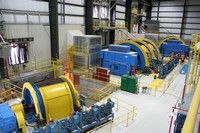Xstrata Nickel’s newest Canadian mine has been designed for improved material handling efficiencies.
Automated systems will be handling three products at Nickel Rim South Mine as employees commission the equipment over the next few months.
Nickel-rich contact ore, copper and precious metal-rich footwall ore, and waste rock will be extracted off two horizons where two identical systems - a conveyor and loading pocket - exist mid-shaft on the 1520-metre level and on the 1700-metre level. Bins will collect material for hoisting to surface.
“It’s really like three small mines as we start,” said John McCall, mechanical engineer and area lead. “The three main levels are not connected yet, which takes away some of the economies of operation.” However, in two to three years, ramps will be constructed to connect the underground workings, creating greater efficiencies.
The majority of the systems that move the material are automated, monitored and controlled from surface. The material is dumped by weight into a flask. When the skip gets into position, the pre-weighed material is dumped and hoisted to surface. Operator intervention is minimal, McCall said, and only required when switching products.
A Blair Hoist, a two-rope system, is a new technology for Xstrata Nickel and the first one built for its Northern Ontario mines. This South African technology uses a two-rope safety system instead of the traditional single rope-counterweight with safety dogs.
The Blair Hoist system has several advantages derived from the constant monitoring of rope loads. Real time rope load data is used for hoist control, allowing the system to respond to unanticipated load changes in a controlled fashion. This results in an increased level of safety and opens up the potential to hoist from greater depths, according to McCall.
Trucking
Three bins on surface arranged over a single lane will collect the three mined products. Because it is a single lane, only one truck can be loaded at any one time.
“We’ll have to get very good at trucking,” McCall said, explaining that between ore and waste, they will eventually be loading a truck every 12 minutes, based on a planned production rate of 1.25 million tonnes of ore and 400,000 tonnes of waste annually.
William Day Mining Services has been contracted to truck the material to the Strathcona Mill. McCall anticipates having about 17 trucks on the road at any one time, which will employ approximately 70 workers.
Currently, the discharge chutes are operated manually, but a scale and an automatic truck loading process has been installed and will be commissioned in the fall.
Ground support materials
In another departure from standard procedure, Nickel Rim South will use shotcrete and rockbolts for primary ground support. Shotcrete, supplied by Fischer Wavy, will be poured through a 10-inch borehole from surface that extends to three different levels underground.
Ballast for road-making, will be moved through a 12-inch borehole from surface, providing a more efficient means to move the material.
Underground services and storage
Mechanical services and storage for equipment and supplies are located underground. Plans to build one main garage on 1480 Level are in progress. The intent is to centralize all of the mobile equipment maintenance in one area underground for greater accessibility and consolidation of services. Additionally, all equipment and commodities required for mining operations will be stored in underground depots, instead of on surface. It takes the cage out of the equation and streamlines the number of people responsible for stocking those items, increasing accountability.
“The logistics of running out of materials underground is a constant issue in mining,” McCall said. “Traditionally, we had a hand-off at the cages, but then you lose accountability. So we’ve changed that so accountability carries right through to the underground depots.”
The benefits of consolidation, automation and design-efficiencies will be more evident within the next several years as the mine enters into full production and facilities are completed.



